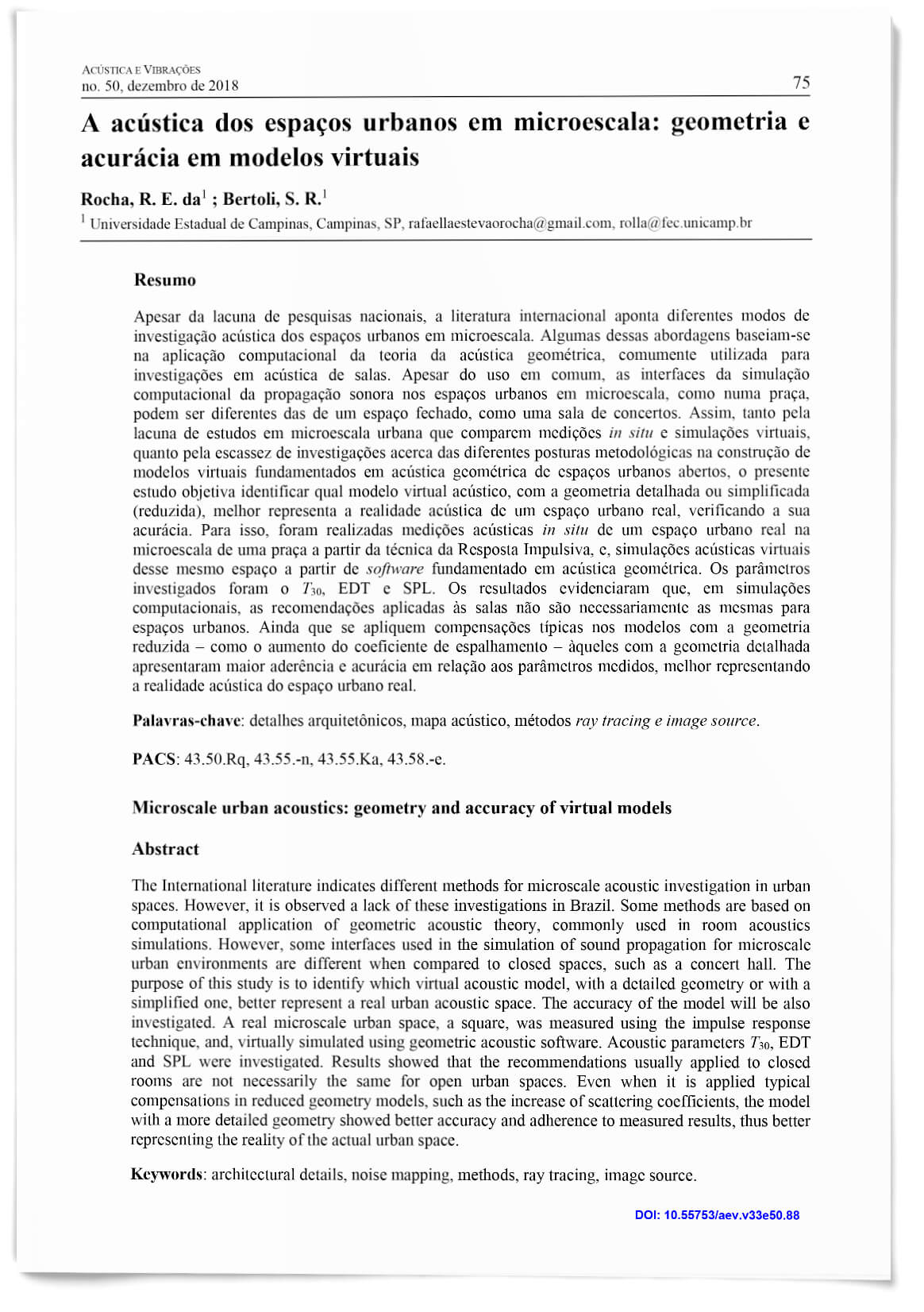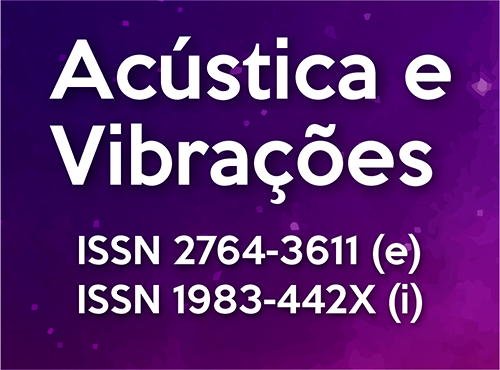La acústica de los espacios urbanos a microescala: geometría y precisión en modelos virtuales
DOI:
https://doi.org/10.55753/aev.v33e50.88Palabras clave:
detalhes arquitetônicos, mapa acústico, métodos ray tracing e image sourceResumen
A pesar de la falta de investigación nacional, la literatura internacional señala diferentes formas de investigar la acústica de los espacios urbanos a microescala. Algunos de estos enfoques se basan en la aplicación computacional de la teoría de la acústica geométrica, comúnmente utilizada para investigaciones en acústica de salas. A pesar de su uso común, las interfaces de simulación por computadora de la propagación del sonido en espacios urbanos a microescala, como una plaza, pueden ser diferentes a las de un espacio cerrado, como una sala de conciertos. Así, tanto por la escasez de estudios sobre microescala urbana que comparen medidas in situ y simulaciones virtuales, como por la escasez de investigaciones sobre las diferentes posturas metodológicas en la construcción de modelos virtuales basados en acústica geométrica de espacios urbanos abiertos, el presente El estudio tiene como objetivo identificar qué modelo acústico virtual, con geometría detallada o simplificada (reducida), representa mejor la realidad acústica de un espacio urbano real, verificando su precisión. Para ello se han realizado medidas acústicas in situ de un espacio urbano real a la microescala de una plaza mediante la técnica de Respuesta Impulsiva, y simulaciones acústicas virtuales de este mismo espacio mediante un software basado en acústica geométrica. Los parámetros investigados fueron T30, EDT y SPL. Los resultados mostraron que, en simulaciones por computadora, las recomendaciones aplicadas a las aulas no son necesariamente las mismas para los espacios urbanos. Aunque las compensaciones típicas se aplican en modelos con geometría reducida, como un aumento en el coeficiente de dispersión, aquellos con geometría detallada mostraron mayor adherencia y precisión en relación con los parámetros medidos, representando mejor la realidad acústica del espacio urbano real.
Citas
KANG, J. Sound Propagation in Interconnected Urban Streets: A Parametric Study. Environment and Planning B: Planning and Design, v. 28, n. 2, p. 281–294, 2001. doi: 10.1068%2Fb2680 DOI: https://doi.org/10.1068/b2680
KANG, J. Urban sound environment. London: Taylor & Francis, 2007. doi: 10.1201/9781482265613 DOI: https://doi.org/10.1201/9781482265613
KANG, J.; MENG, Y.; BROWN, G. J. Sound propagation in micro-scale urban areas: simulation and animation. In: Euronoise, Nápoles, Itália: 2003.
ATTENBOROUGH, K.; LI, K.; HOROSHENKOV, K. Predicting outdoor sound. London: Taylor & Francis, 2007. doi: 10.1201/9781482295023 DOI: https://doi.org/10.1201/9781482295023
PROBST, W. Uncertainty and quality assurance in simulation software. In: Noise mapping in the EU models and procedures. Boca Raton: CRC Press, Taylor & Francis Group, 2013. doi: 10.1201/b12885 DOI: https://doi.org/10.1201/b12885
LYON, R. H. Role of multiple reflections and reverberation in urban noise propagation. The Journal of the Acoustical Society of America, v. 55, n. 3, p. 493–503, 1974. doi: 10.1121/1.1914527 DOI: https://doi.org/10.1121/1.1914527
DAVIES, H. G. Multiple‐reflection diffuse‐scattering model for noise propagation in streets. The Journal of the Acoustical Society of America, v. 64, n. 2, p. 517–521, 1978. doi: 10.1121/1.382002 DOI: https://doi.org/10.1121/1.382002
PICAUT, J.; SIMON, L. A scale model experiment for the study of sound propagation in urban areas. Applied Acoustics, v. 62, n. 3, p. 327–340, 2001. doi: 10.1016/S0003-682X(00)00028-1 DOI: https://doi.org/10.1016/S0003-682X(00)00028-1
KANG, J. Numerical modelling of the sound fields in urban streets with diffusely reflecting boundaries. Journal of Sound and Vibration, v. 258, n. 5, p. 793–813, 2002. doi: 10.1006/jsvi.2002.5150 DOI: https://doi.org/10.1006/jsvi.2002.5150
ONAGA, H.; RINDEL, J. H. Acoustic characteristics of urban streets in relation to scattering caused by building facades. Applied Acoustics, v. 68, n. 3, p. 310–325, 20075. doi: 10.1016/j.apacoust.2006.01.010 DOI: https://doi.org/10.1016/j.apacoust.2006.01.010
CAN, A.; FORTIN, N.; PICAUT, J. Accounting for the effect of diffuse reflections and fittings within street canyons, on the sound propagation predicted by ray tracing codes. Applied Acoustics, v. 96, p. 83–93, 2015. doi: 10.1016/j.apacoust.2015.03.013 DOI: https://doi.org/10.1016/j.apacoust.2015.03.013
EUROPEAN COMISSION. Good practice guide for strategic noise mapping and the production of associated data on noise exposure. WG-AEN. Versão 2. Versão final. 13 jan. 2006.
ROCHA, R. E. da; BERTOLI, S. R.; MAIORINO, A. V. Environmental noise performance: the detail of the building shape influence. In: Internoise, San Francisco, CA, USA: 2015. Disponível em: https://www.ingentaconnect.com/content/ince/incecp/2015/00000250/00000003/art00016
FASTL, H.; ZWICKER, E. Psychoacoustics: facts and models. 3. ed. Berlin; New York: Springer, 2007. DOI: https://doi.org/10.1007/978-3-540-68888-4
LICITRA, G.; MEMOLI, G. Limits and advantages of Good Practice Guide to noise mapping. In: Acoustic’08 Paris. Paris: 2008. DOI: https://doi.org/10.1121/1.2932687
KLÆBOE, R.; ENGELIEN, E.; STEINNES, M. Context Sensitive Noise Impact Mapping. Applied Acoustics, v. 67, n. 7, p. 620–642, jul. 2006. doi: 10.1016/j.apacoust.2005.12.002 DOI: https://doi.org/10.1016/j.apacoust.2005.12.002
ROCHA, R. E. da; BERTOLI, S. R. A acústica urbana e suas escalas de investigação. Acústica e Vibrações, v. 1, n. 48, p. 29–44, 2016.
TSAI, K.-T.; LIN, M.-D.; CHEN, Y.-H. Noise Mapping in Urban Environments: A Taiwan Study. Applied Acoustics, v. 70, n. 7, p. 964–972, 2008. doi: 10.1016/j.apacoust.2008.11.001 DOI: https://doi.org/10.1016/j.apacoust.2008.11.001
HORNIKX, M. Ten questions concerning computational urban acoustics. Building and Environment, p. 1–13, 2016. doi: 10.1016/j.buildenv.2016.06.028 DOI: https://doi.org/10.1016/j.buildenv.2016.06.028
HOWARTH, M. J.; LAM, Y. W. An assessment of the accuracy of a hybrid room acoustics model with surface diffusion facility. Applied Acoustics, v. 60, n. 2, p. 237–251, 2000. doi: 10.1016/S0003-682X(99)00059-6 DOI: https://doi.org/10.1016/S0003-682X(99)00059-6
KUTTRUFF, H. Room acoustics. 5. ed. Boca Raton: CRC Press, 2009. doi: 10.1201/9781482266450 DOI: https://doi.org/10.1201/9781482266450
CHRISTENSEN, C. L.; KOUTSOURIS, G.; GIL, J. ODEON room acoustics software version 13: user’s manual. Denmark: ODEON S/A, Scion DTU, 2016.
BORK, I. A comparison of room simulation software - the 2nd Round Robin on room acoustical computer simulation. Acta Acustica united with Acustica, v. 86, n. 6, p. 943–956, 2000.
BORK, I. Report on the 3rd Round Robin on Room Acoustical Computer Simulation – Part I: Measurements. Acta Acustica united with Acustica, v. 91, n. 4, p. 740–752, 1 jul. 2005.
VORLÄNDER, M. Internacional Round Robin on room acoustical computer simulations. In: ICA, Trondheim, Noruega: 1995.
ROCHA, R. E. da; BERTOLI, S. R. Outros olhares para o espaço urbano em microescala: uma revisão narrativa de simulações virtuais fundamentadas em acústica geométrica. In: XXVIII Encontro da SOBRAC, Porto Alegre, RS: 2018. doi: 10.17648/sobrac-87030 DOI: https://doi.org/10.17648/sobrac-87030
ROCHA, R. E. da; BERTOLI, S. R.; MAIORINO, A. V. Reducing geometry or detailing? Comparison between measured and modeled microscale urban spaces. POMA/ASA, v. 28, n. 015011, 2017. doi: 10.1121/2.0000391 DOI: https://doi.org/10.1121/2.0000391
ROCHA, R. E. da; MAIORINO, A. V.; BERTOLI, S. R. Accuracy of computer simulation software using hybrid models for microscale urban environments. POMA/ASA v. 28, n. 015012, 2017. doi: 10.1121/2.0000412 DOI: https://doi.org/10.1121/2.0000412
EL DIEN HH, WOLOSZYN P. The acoustical influence of balcony depth and parapet form: experiments and simulations. Applied Acoustics. v. 66, n.2, p.533–51, 2005. doi: 10.1016/j.apacoust.2004.09.004 DOI: https://doi.org/10.1016/j.apacoust.2004.09.004
MORI J, YOSHINO D, SATOH F, TACHIBANA H. Prediction of outdoor sound propagation by applying geometrical sound simulation technique. In: Internoise. Osaka, Japão:2011
MORI J, SATOH F, YOKOYAMA S, TACHIBANA H. Prediction of outdoor sound propagation by geometrical computer modeling. Acoustical Science and Technology. v.35, n.1,p.50-54, 2014. doi: 10.1250/ast.35.50 DOI: https://doi.org/10.1250/ast.35.50
PAINI D, GADE AC, RINDEL JH. Agorá acoustics - Effects of arcades on the acoustics of public squares. In: Forum Acoustics, p. 1813–8. Budapeste, Hungria; 2005.
MORI J, YOSHINO D, SATOH F, TACHIBANA H. Prediction of outdoor sound propagation by applying geometrical sound simulation technique. In: Internoise, p. 3079–83. Osaka, Japão: 2011.
BORK, I. A comparison of room simulation software - the 2nd Round Robin on room acoustical computer simulation. Acta Acustica united with Acustica, v. 86, n. 6, p. 943–956, 2000.
LISA, M.; HOLGER RINDEL, J.; CHRISTENSEN, C. L. Predicting the acoustics of ancient open-air theatres: the importance of calculation methods and geometrical details. In: BNAM, Mariehamn, Finlândia. Anais... In: BNAM. Mariehamn, Finlândia: 2004. Disponível em: https://citeseerx.ist.psu.edu/viewdoc/summary?doi=10.1.1.488.8560
KANG, J. Sound propagation in street canyons: Comparison between diffusely and geometrically reflecting boundaries. The Journal of the Acoustical Society of America, v. 107, n. 3, p. 1394–1404, 2000. doi: 10.1121/1.428580 DOI: https://doi.org/10.1121/1.428580
MENG, Y.; KANG, J. Combined ray-tracing and radiosity simulation for urban open spaces. In: ICA, Madri, Espanha. Anais... In: ICA. Madri, Espanha: 2007.
PICAUT et al. Experimental study of sound propagation in a street. Applied Acoustics, Urban AcousticsUrban Acoustics. v. 66, n. 2, p. 149–173, 2005. doi: 10.1016/j.apacoust.2004.07.014 DOI: https://doi.org/10.1016/j.apacoust.2004.07.014

Descargas
Publicado
Cómo citar
Número
Sección
Licencia
Derechos de autor 2018 Acústica e Vibrações

Esta obra está bajo una licencia internacional Creative Commons Atribución-NoComercial-CompartirIgual 4.0.




